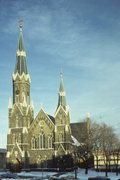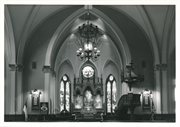Property Record
1046 N 9TH ST
Architecture and History Inventory
| Historic Name: | Trinity Evangelical Lutheran Church |
|---|---|
| Other Name: | TRINITY LUTHERAN CHURCH |
| Contributing: | |
| Reference Number: | 27249 |
| Location (Address): | 1046 N 9TH ST |
|---|---|
| County: | Milwaukee |
| City: | Milwaukee |
| Township/Village: | |
| Unincorporated Community: | |
| Town: | |
| Range: | |
| Direction: | |
| Section: | |
| Quarter Section: | |
| Quarter/Quarter Section: |
| Year Built: | 1878 |
|---|---|
| Additions: | 1880 |
| Survey Date: | 1984 |
| Historic Use: | house of worship |
| Architectural Style: | Early Gothic Revival |
| Structural System: | |
| Wall Material: | Cream Brick |
| Architect: | Frederick Velguth |
| Other Buildings On Site: | |
| Demolished?: | No |
| Demolished Date: |
| National/State Register Listing Name: | Trinity Evangelical Lutheran Church |
|---|---|
| National Register Listing Date: | 5/8/1979 |
| State Register Listing Date: | 1/1/1989 |
| National Register Multiple Property Name: |
| Additional Information: | A 'site file' exists for this property. It contains additional information such as correspondence, newspaper clippings, or historical information. It is a public record and may be viewed in person at the Wisconsin Historical Society, Division of Historic Preservation-Public History. THIS CHURCH IS THE "MOTHER" CHURCH OF LUTHERANISM IN MILWAUKEE; CONGREGATION WAS FORMED IN 1847. HABS WI-273. With its impressive brickwork and stone trim outside, and its ornate woodwork inside, Trinity was heralded as the "finest church edifice within the Missouri Synod" soon after its consecration. Two towers of uneven height dominate the west (Ninth Street) facade. Real Medieval churches commonly built towers only when money became available, so style could show when a second tower was built. Trinity's faceted spires reappear in the pinnacles of the sounding board, capping this beautiful display of woodworking. The design may have been borrowed from a similar pulpit in Germany's Wartburg Chapel, where Martin Luther took refuge in the sixteenth century. The church was damaged by fire on 5/15/2018. "Trinity is one of the most remarkable Lutheran churches built in America during the 1870s. Its design blazed new ground with its superlative combination of the American High Victorian Gothic features and traditional German Gothic forms. Built of Milwaukee cream brick and trimmed with Illinois sandstone and extensive ornamental sheet metal, it was justly called the "finest Lutheran church edifice within the Missouri Synod," when it opened. The highly ornamented brick work found on the exterior walls of the church is characteristic of late medieval church architecture found in Northern Germany where many of Trinity's members had been born. where the side walls meet the roof, for example, the brick is laid in a repeated pattern of small, pointed arches, called a corbel table frieze, which was common among German Gothic and Romanesque style brick religious buildings. The crown-like gables that encircle the tops of the towers are also part of a building tradition strongly associated with the Germans. A visit to the interior is essential in order to fully appreciate the remarkable craftsmanship on this structure which contains some of the most outstanding church woodwork of its era. At the base of the staircase in the larger tower, for example, the huge newel post is a flamboyant example of the American High Victorian Gothic style exuberantly executed in the bold style preferred by Trinity's German-born architect and patrons. The focal points of the church auditorium are its magnificent natural wood altar and the raised, goblet-shaped pulpit. The pulpit which is topped with a carved wooden sounding board, was described in the 1880s as a "monument to the woodworkers' art," and its design is believed to be based on a similar pulpit in Germany's famous Wartburg chapel where Martin Luther, the founder of Lutheranism, took refuge in the sixteenth century. The pulpit is reached by a splendid curved staircase that ranks among the finest wooden features in American church architecture. Trinity church marked the high-point in the design career of its German-born architect, Frederick Velguth. He first established himself as a master carpenter and contractor before moving on to become an architect who designed many fine buildings in the city, including Christ Church at 2235 West Greenfield Avenue. Trinity is the second oldest oldest Lutheran congregation in the city. It was founded in 1847 by a group of Germans from Pomerania, now part of northeastern Germany and western Poland. The early congregation included some of the most prominent German-American business and professional figures in the city, including Captain Frederick Pabst whose Pabst Brewing Co. complex is located across the street from the church. Today, the socially and ethnically diverse congregation takes great pride in their church building which is both a local and national landmark." MILWAUKEE ETHNIC CHURCH TOUR, CITY OF MILWAUKEE DEPARTMENT OF CITY DEVELOPMENT, 1994. |
|---|---|
| Bibliographic References: | THE HISTORIC NAME, DATE OF CONSTRUCTION, AND ARCHITECT ARE FROM THE NR NOMINATION. MILWAUKEE ETHNIC CHURCH TOUR, CITY OF MILWAUKEE DEPARTMENT OF CITY DEVELOPMENT, 1994. BUILT IN MILWAUKEE, LANDSCAPE RESEARCH, P. 133, P. 138. HOUSE OF WORSHIP. Buildings of Wisconsin manuscript. https://www.jsonline.com/story/news/local/milwaukee/2018/05/15/historic-downtown-milwaukee-church-engulfed-flames/613124002/ Pagel, Mary Ellen & Virginia A Palmer, University Extension The University of Wisconsin, Guides to Historic Milwaukee: Kilbourntown Walking Tour, 1967. |
| Wisconsin Architecture and History Inventory, State Historic Preservation Office, Wisconsin Historical Society, Madison, Wisconsin |





